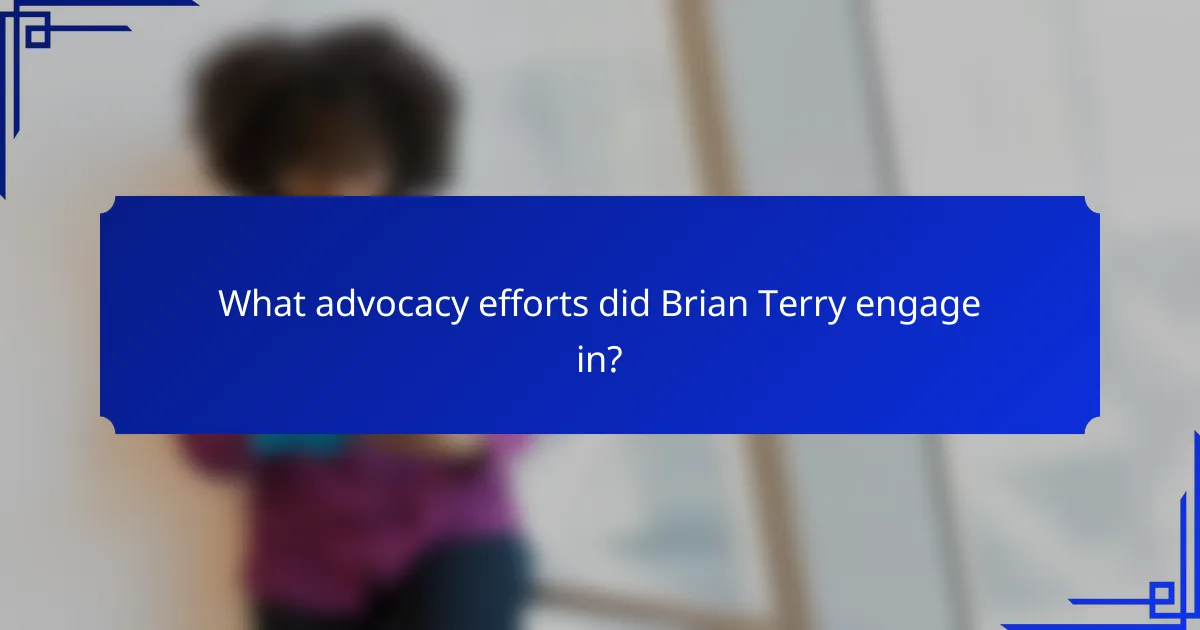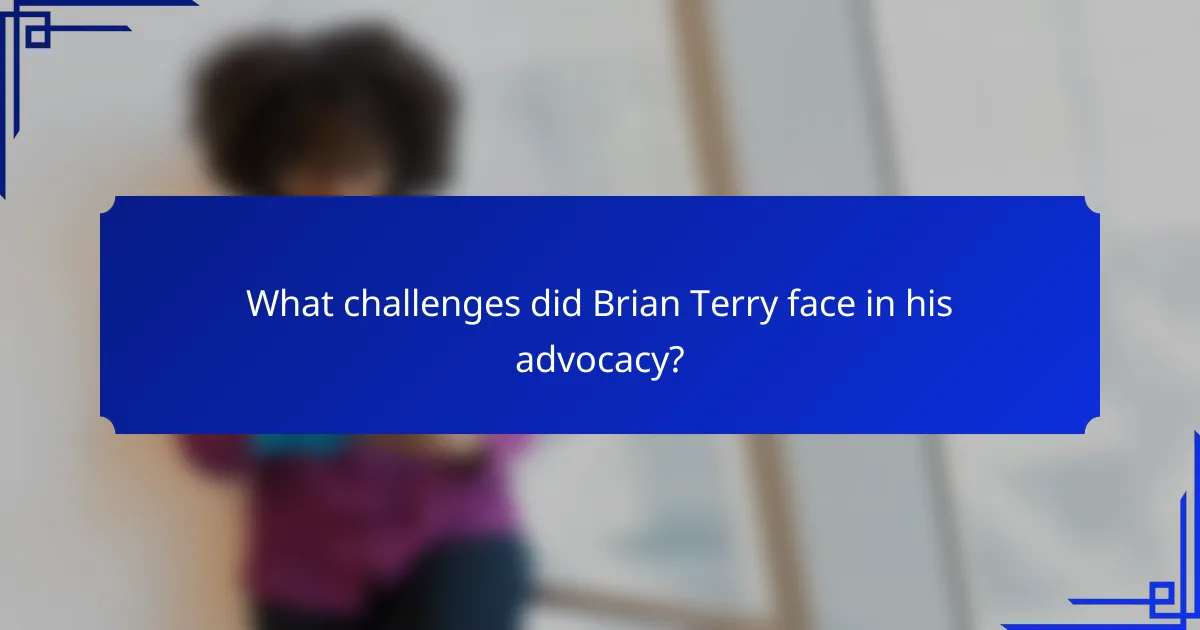Brian Terry’s advocacy work in border security and immigration reform was profoundly shaped by his personal experiences and the challenges he encountered. Motivated by a desire for change, he became a passionate advocate, striving to raise awareness and promote effective solutions despite facing significant political and resource-related obstacles.

How did Brian Terry’s experiences shape his advocacy?
Brian Terry’s personal experiences significantly influenced his advocacy work, particularly in the areas of border security and immigration reform. His background and the challenges he faced motivated him to become a vocal proponent for change in these critical areas.
Personal background influences
Brian Terry grew up in a family that valued hard work and community service, instilling in him a strong sense of responsibility towards others. His upbringing in a border town exposed him to the complexities of immigration and law enforcement from an early age, shaping his perspective on these issues.
His experiences as a U.S. Border Patrol agent further deepened his understanding of the challenges faced by both law enforcement and immigrants. This dual perspective allowed him to advocate for policies that balanced security with compassion, reflecting his belief in the importance of humane treatment for all individuals.
Key events that motivated advocacy
A pivotal moment in Terry’s advocacy journey was his tragic death in 2010 during a confrontation with drug traffickers. This event highlighted the dangers faced by border agents and underscored the urgent need for reform in border security policies. His death sparked national conversations about the effectiveness of existing laws and the need for comprehensive immigration reform.
In the aftermath, Terry’s family and supporters rallied to honor his legacy by pushing for changes that would improve safety for border agents and address the root causes of immigration issues. Their efforts have continued to inspire advocacy aimed at creating a more effective and humane immigration system.

What advocacy efforts did Brian Terry engage in?
Brian Terry was deeply involved in advocacy efforts focused on border security and community outreach. His personal experiences shaped his commitment to these causes, aiming to raise awareness and promote effective solutions.
Border security initiatives
Brian Terry’s advocacy for border security initiatives centered on enhancing safety and reducing illegal activities at the U.S.-Mexico border. He supported measures such as increased funding for border patrol and the implementation of advanced surveillance technologies to monitor border crossings.
One key aspect of these initiatives was the promotion of collaboration between federal and local law enforcement agencies. This approach aimed to improve communication and resource sharing, ultimately leading to more effective enforcement of immigration laws and protection of communities.
Community outreach programs
In addition to border security, Brian Terry was passionate about community outreach programs that educated residents on the complexities of immigration and border issues. These programs often included workshops and public forums designed to foster dialogue and understanding among diverse community members.
Through these outreach efforts, Terry aimed to bridge gaps between law enforcement and local populations, encouraging a cooperative approach to addressing concerns related to immigration. He believed that informed communities could better advocate for their needs while supporting lawful immigration processes.

What challenges did Brian Terry face in his advocacy?
Brian Terry faced significant challenges in his advocacy, primarily stemming from political opposition and resource limitations. These obstacles hindered his efforts to promote effective policies and raise awareness about critical issues.
Political opposition
Political opposition played a crucial role in the challenges Brian Terry encountered. His advocacy efforts often clashed with established political interests that resisted changes to existing policies. This resistance made it difficult to gain traction for his initiatives and required him to navigate a complex landscape of competing agendas.
For instance, Terry’s focus on border security and immigration reform faced pushback from various political factions that had differing views on these issues. This opposition not only slowed down progress but also complicated the dialogue around potential solutions.
Resource limitations
Resource limitations significantly impacted Brian Terry’s advocacy work. Limited funding and manpower restricted his ability to reach broader audiences and implement comprehensive programs. Without adequate resources, it became challenging to sustain momentum and effectively communicate his message.
Advocates in similar positions often face these constraints, which can include insufficient staff, lack of access to technology, or inadequate funding sources. To overcome these limitations, building partnerships with other organizations and seeking grants can be effective strategies to enhance advocacy efforts.

How can individuals learn from Brian Terry’s advocacy?
Individuals can learn from Brian Terry’s advocacy by understanding the importance of personal experiences in driving social change. His journey highlights how personal stories can effectively mobilize communities and influence policy discussions.
Effective communication strategies
Effective communication is crucial for advocacy, as it helps convey messages clearly and persuasively. Utilizing storytelling techniques can make personal experiences relatable, allowing audiences to connect emotionally with the cause. For instance, sharing specific anecdotes about challenges faced can illustrate broader issues and inspire action.
Advocates should also consider their audience when crafting messages. Tailoring communication to resonate with different groups—whether policymakers, community members, or the media—can enhance engagement. Using clear, concise language and avoiding jargon ensures that the message is accessible to all.
Building community support
Building community support is essential for effective advocacy, as it creates a network of allies who can amplify the message. Engaging local organizations and stakeholders can foster collaboration and strengthen the movement. Hosting community events or forums can provide platforms for discussion and mobilization around shared goals.
Additionally, leveraging social media can expand outreach and connect with a broader audience. Regular updates on advocacy efforts and success stories can keep the community informed and motivated. Encouraging community members to share their own experiences can further enrich the collective narrative and drive momentum for change.

What impact did Brian Terry have on policy changes?
Brian Terry’s tragic death significantly influenced policy changes regarding border security and immigration enforcement in the United States. His case highlighted the need for reforms in law enforcement practices and legislative measures aimed at preventing similar incidents in the future.
Legislative reforms
Following Brian Terry’s death, lawmakers introduced various legislative reforms aimed at enhancing border security and accountability within law enforcement agencies. These reforms often focused on increasing funding for border patrol and improving coordination between federal and local law enforcement.
One notable outcome was the push for stricter regulations on firearms trafficking, particularly concerning the sale of weapons to suspected criminals. This included proposals to close loopholes that allowed for the easy purchase of firearms without background checks.
Influence on law enforcement practices
Terry’s case prompted law enforcement agencies to reevaluate their operational practices, particularly in relation to cross-border crime. Agencies began implementing more rigorous training programs for officers, emphasizing the importance of intelligence sharing and cooperation with federal authorities.
Additionally, there was a growing emphasis on community policing strategies, which aimed to build trust between law enforcement and local communities. This shift sought to improve communication and collaboration, ultimately leading to more effective crime prevention efforts along the border.

How is Brian Terry’s legacy remembered today?
Brian Terry’s legacy is remembered through various memorial events and ongoing advocacy efforts aimed at addressing border security and immigration reform. His tragic death while serving as a Border Patrol agent has galvanized support for policy changes and raised awareness about the complexities of immigration issues.
Memorial events
Memorial events honoring Brian Terry take place annually, often near the anniversary of his death. These gatherings serve to remember his sacrifice and to advocate for improved border security measures. Family members, colleagues, and community supporters participate in these events, sharing stories and calling for policy reforms.
In addition to annual memorials, there are occasional special events, such as fundraisers or awareness campaigns, that focus on the issues surrounding border security. These events aim to educate the public and encourage dialogue about the challenges faced by law enforcement at the border.
Ongoing advocacy organizations
Several advocacy organizations continue to promote the values and issues associated with Brian Terry’s legacy. Groups like the Border Patrol Foundation and the National Border Patrol Council work to support the families of fallen agents and advocate for safer working conditions. They often engage in community outreach to raise awareness about the dangers faced by border agents.
These organizations also push for legislative changes to enhance border security and improve immigration policies. They provide resources for families affected by similar tragedies and work to ensure that the sacrifices of agents like Brian Terry are not forgotten.

What future trends in advocacy can be drawn from Brian Terry’s story?
Brian Terry’s story highlights the growing significance of personal experiences in shaping advocacy efforts. His journey illustrates how individual narratives can galvanize communities and influence policy changes.
Emerging grassroots movements
Grassroots movements are increasingly becoming a powerful force in advocacy, often fueled by personal stories like Terry’s. These movements typically arise from local communities and focus on specific issues, allowing individuals to mobilize and create change from the ground up.
For example, community-led initiatives addressing immigration reform or gun control often gain traction through shared experiences that resonate with a broader audience. These movements can leverage social media to amplify their message and connect with supporters nationwide.
Increased focus on personal narratives
Personal narratives are becoming central to advocacy strategies, as they humanize issues and foster empathy among audiences. Advocates are encouraged to share their own stories to illustrate the real-world impact of policies and decisions.
Effective storytelling can drive engagement and support, making it crucial for advocates to refine their narratives. They should focus on clarity and emotional resonance, ensuring their experiences are relatable and impactful to others. This approach not only raises awareness but also encourages action among supporters and policymakers alike.
